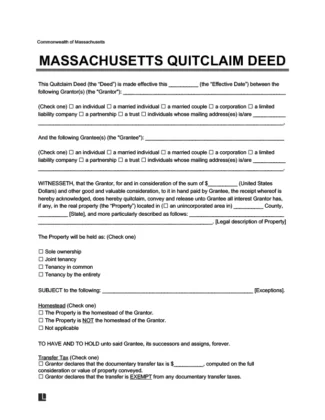

A Massachusetts quitclaim deed conveys property from one party to another without any warranties or guarantees of a clear title before the current owner possessed the property. However, under this deed, the grantor will defend against all issues that arise from their ownership period.
Please note that Massachusetts has different rules for quitclaim deeds than other states. It uses a release deed instead of a quitclaim deed to transfer warranty-free property.
Mass. Gen. Laws ch. 183 (Alienation of Land) details land transfers. Further into the chapter in Mass. Gen. Laws. ch. 183 § 2, you’ll find a definition for quitclaim deeds and a reference that makes them legally enforceable in the state. Chapter 183 also contains an appendix listing various statutory forms for real estate instruments, including quitclaim deeds.
A quitclaim deed must have a legal description that clearly identifies the property. The state has come to enforce this requirement due to case law, particularly McHale v. Treworgy, 90 N.E.2d 908 (Mass. 1950). The legal description should include one of the following elements:
The grantor should sign a quitclaim deed, like other legal documents transferring real estate, in the presence of a notary (Mass. Gen Laws ch. 183 § 29). The notary’s signature and seal will certify the document as valid.
Mass. Gen. Laws ch. 183 § 17 provides the appropriate terminology for a quitclaim deed. The grantor should include the phrase “quitclaim covenants” or “limited covenants” to confirm they will defend against lawful demands of all persons claiming by, through, or under the grantor but against no one else.
Mass. Gen. Laws ch. 183 § 4 declares the grantor must file a quitclaim deed with the Registry of Deeds Office in the relevant county. They should prepare to pay a $155 filing fee for their deed.
A buyer can inherit the title on their own, but they can also take it through one of these three methods:
Massachusetts’ statutes don’t dictate the specific formatting requirements for deeds. Instead, the Massachusetts Registers and Assistant Registers of Deeds Association released Deed Indexing Standards that govern the formatting standards for deeds (950 Mass. Reg. 120.04). Explore some of the main points below:
These standards are subject to revision, so please note that the parties should adhere to the most recent revisions.
When filling out a quitclaim deed, ensure that it includes all relevant content to identify all parties involved in the transfer and the specific parcel of land. This means the document should contain:
A quitclaim deed should also include a full description of the warranty conveyed at the time of the property transfer and what it does not cover. Since a Massachusetts quitclaim deed, unlike quitclaim deeds in other states, includes a partial warranty, the deed should name the period covered by the warranty and the grantor’s guarantee that they have done nothing to create title issues.
| Quitclaim Deed | Provides a limited warranty of title during the property transfer. It's often restricted to just the grantor's ownership period. |
| Warranty Deed | Provides a complete warranty of title during the property transfer. |
| Release Deed | Similar to a quitclaim deed in other states; it only transfers property without making any promises or warranties. |
| Life Estate Deed | Delegates property ownership to two parties: the life tenant and the remainder beneficiary. The life tenant can only transfer their interest (the life estate) during their lifetime. They must obtain permission from the remainder beneficiary to transfer the entire property's title. |
| Enhanced Life Estate Deed (Lady Bird Deed) | Similar to a life estate deed, but allows the life tenant more autonomy over decisions regarding the property's title. |